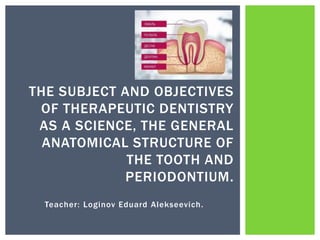The document provides an overview of therapeutic dentistry, detailing its subject, objectives, and the anatomical structure of teeth and periodontium. It emphasizes the importance of prevention, diagnosis, and treatment of dental diseases, highlighting the relationship between dental health and systemic conditions like diabetes and cardiovascular diseases. Moreover, it discusses tooth anatomy, including the structure of enamel, dentin, cement, and pulp, as well as the classifications and functions of different types of teeth.









































